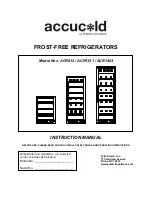
7
Use of the refrigerator compartment
To achieve the best results with the refrigerator
compartment, you should follow one or two very
simple rules:
Do not put warm foods or evaporating liquids in the
refrigerator.
Cover or wrap foods (particularly if they have a
strong smell or contain aromatic herbs).
Do not cover the shelves (grids) with paper or
plastic since this blocks circulation of air in the
compartment.
Use of the «Wine Cellar» compartment
(Fig. 4)
Through a simple operation this refrigerator makes
it possible to obtain a «mild» temperature in
compartments (d)-(e) in that an ideal «wine cellar»
temperature is reached there.
Lower compartments (d)-(e) are separated from the
rest by a shelf.
This shelf features a lever (F), which controls the
cold air flow through a number of openings in the
shelf itself.
Slide this lever to «0» position to obtain a «wine
cellar» temperature.
By slipping it to position «5» this section can be
used as a normal refrigerator.
On positions «1» through «4» intermediate
temperatures are obtained.
Storage of foods
Fig. 4 gives some indications as to the best way to
store foodstuffs and drinks in the various
compartments, i.e.:
Freezer
(a)
This is for storing frozen food and for freezing
fresh food.
Refrigerator
(b)
This is for storing soft cheese, blue cheese, etc.
(c)
This is for storing meat, fresh fish, milk, yoghurt
(this is the coolest part of the refrigerator).
«Wine Cellar»
(d)
This is for storing wine, fruit, unripe tomatoes,
potatoes, lemons, sausages, soft drinks, hard cheese,
canned food, etc.
(e)
This is for storing fresh vegetables.
Fig. 4
D271gb
Freezer
Refrigerator
Wine cellar
0
1
2
3
4
5
a
b
b
b
c
d
e
0
1
2
3
4
5
F




























